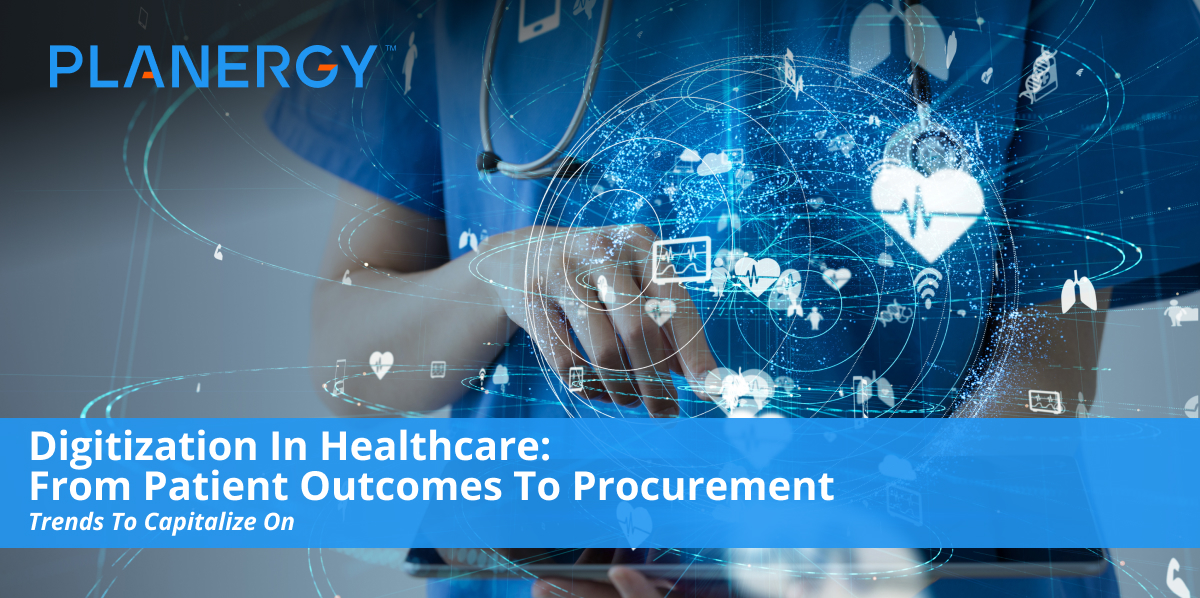In healthcare, it can be overwhelming to keep up with digital transformation. Choosing which technologies to invest in and getting a team on board with the changes is usually the most difficult aspect.
Adapting to digital transformation requires shifting toward a flexible mindset that doesn’t mind taking a bit of risk.
It means eliminating outdated business processes and leaning into the fact that the disruption will give you good results.
Before we go any further, let’s take a closer look at what digital transformation in healthcare actually is. it is the positive impact of technology in the healthcare industry.
Artificial intelligence-enabled medical devices, blockchain electronic health records, and telemedicine are a few examples of why digital transformation in healthcare is important and how it completely reshapes the way people interact with their healthcare professionals, how the data is shared across providers, and how medical professionals make decisions about health outcomes and treatment plans.
The digitization of healthcare aims to streamline work, improve patient outcomes, reduce human error, optimize systems, and lower costs.
Unfortunately, the healthcare sector and pharmaceuticals are behind the rest of the world when it comes to implementing digital transformation practices. Data shows that only 7% of medical companies say they’ve gone digital, compared to 15% of companies and other Industries.
The United States healthcare market is huge, with national health spending projected to reach $5.7 trillion by 2026.
That means there’s still plenty of time for businesses in health care to learn about digital technology and implemented it to grow. But, before you can transform healthcare services to improve the patient experience, you have to fully understand the modern healthcare landscape.
With 8 years of Technology, patients are getting better treatment than ever courtesy of wearable medical devices, 5G mobile technology, telehealth, and even virtual reality tools.
Medical professionals, on the other hand, are using technology to stream their workflows with artificial intelligence.
Let’s look at some of the digitization trends in healthcare today.
Increased Importance of Big Data in Healthcare
Big data collects information about a business and a variety of formats. And includes things like online transactions, financial transactions, social media, and e-commerce.
With big data, the information is aggregated to identify patterns and trends to help provide decision support. In the healthcare industry, this big data provides numerous benefits such as:
More Accurate Staffing:
Predictive analysis can help medical offices, clinics, and hospitals, estimate future admissions rates. This information makes it easier for facilities to allocate the proper staff required to deal with the patient load. It helps to save money and cuts emergency room wait times as a result of a facility being understaffed.
Reduction in Medication Errors:
With patient record analysis, the software can easily flag inconsistencies between patients’ health and medication prescriptions. when it sees a potential medication error, it can alert both patients and professionals for intervention before something goes wrong.
Preventative Care:
A large volume of people seeking care in the emergency room are recurrent patients. They can account for up to 28% of visits. With data analysis, you can easily identify these people and create preventive healthcare plans to stop them from coming back.
Keeping these benefits in mind, health care companies should make investing in their data organization a priority.
By investing in analytics experts to crunch the data and find areas of weakness, companies can also help them to better understand the market.
For instance, in the pharmaceutical industry, marketing dynamics are constantly changing.
Many drug makers believe the biggest benefit of big data is how it helps them to improve their market understanding. With that information, they can determine product budgets and product iteration based on current and forecasted demand.
With a clear understanding of the market, healthcare and marketing and sales teams can more easily identify the ideal consumer.
It makes it easier to create your customer persona and highlight the platforms where you can reach them.
In today’s healthcare ecosystem, embracing digital technology is a must. It touches every aspect of healthcare, including procurement.
Numerous Applications of AI
Data shows that the healthcare AI-powered tools market is expected to reach $34 billion by 2025, meaning that the technology will shape almost every aspect of the industry. And we’re not just talking about nurse robots.
Virtual health assistants and chatbots help to fill a variety of roles ranging from diagnostic tools to customer service representatives and even therapists. The global healthcare chatbots market is projected to reach $314.3 billion by 2023.
AI is also powerful when it comes to things like genomics, Medical Imaging, drug discovery, and precision medicine.
For instance, cancer patients used to receive standardized cookie-cutter treatments with high failure rates. But because of AI pattern recognition and machine learning, patients are now getting access to highly personalized therapy tailored specifically to their lifestyle and genetic makeup, for a better quality of care.
What AI-powered programs are doing for oncology is analyzing thousands of pathology images of a variety of cancers to provide more accurate diagnoses and predict the best possible anti-cancer drug combinations.
And when it comes to medical imaging diagnostics, the technology is helping radiologists spot details the human eye can’t see.
AI is also helping to shorten the drug development cycle. Recent studies show that AI can cut early drug discovery times by 4 years compared to the industry average and generate 60% cost savings. Data shows that AI is projected to bring $150 billion in annual savings to the US healthcare economy by 2026.
AI can also help automate procurement processes, to help clinicians save time and money on equipment and supplies. Those savings can be passed down to the payers in the form of lower overall treatment costs.
Rapid Growth in On-Demand Healthcare
On-demand is an increasingly popular trend among consumers. They want things on their own time, when it is most convenient, wherever they may be.
As people have become more mobile, they expect health care to follow along. Data shows that more than half of all web browsing occurs on mobile devices.
Adjusting strategies to reach your target consumers online is crucial to building a thriving practice. Today’s consumers are going online to research doctors, hospitals, and medical facilities but most often they book medical appointments.
On-demand healthcare is also growing thanks to the gig economy we’re freelance professionals who work various gigs instead of remaining with a single company.
Nomad Health is an online marketplace that connects doctors directly with medical facilities for short-term work. This makes it easier for doctors to provide on-demand healthcare to clients in various circumstances that match their schedule, expertise, and clients.
Doctors themselves are now becoming on-demand healthcare providers to better meet the changing needs of their patients.
Increase in Wearable Medical Devices
Companies are now collecting their own health data from medical devices such as wearable technology.
In the past, many patients were satisfied with visiting their doctor once a year for a physical and only checking in if something was wrong.
But in today’s digital age, patients are focusing more on maintenance and prevention and want information about their health more often.
Because of this, healthcare companies are proactively investing and wearable technology devices that can provide monitoring of high-risk patients to determine how likely a major health event is to occur.
Recent data suggests that the wearable medical device market is expected to reach over $27 million by 2023 – a nearly $8 million increase since 2017.
Wearable medical devices include things such as:
- Sweat meters for diabetics to monitor blood sugar levels
- Heart rate sensors
- Exercise tracker
- Oximeters to monitor the amount of oxygen carried in the blood
Are companies that invest in these products also get other benefits, including:
- Gamification opportunities: Some medical devices like fitness watches can create goals for users to reach through nutrition, diet, and exercise.
- Targeted Insurance pricing: Information from wearable devices can help insurance companies more accurately assess pricing for a patient’s risk of illness
- Insurance incentives: Patients who opt for preventive measures can get lower health insurance premiums
- Personalized healthcare experiences: Medical devices give patients a sense of ownership of their role and improve their health.
If that’s not enough, research shows that wearable technology can also help companies save money. Health apps and wearables for preventive care save the US healthcare system nearly $7 billion a year.
Using Virtual Reality to Treat Patients
Just a decade ago telling someone you could relieve their pain with a device similar to a video game would have made people look at you like you were crazy.
In today’s market, virtual reality is a major part of healthcare’s digital transformation. It has a variety of applications that are dramatically changing the wave patients get treatment.
Pain management is a prime example. Until recently, doctors were prescribing opioids heavily. As such, America is facing its worst drug crisis costing the economy $78.5 billion a year.
CDC data indicates that millions of adults are still dealing with chronic pain. Virtual reality advancements provide a safer and more efficient drug alternative. With it, doctors are treating pain, anxiety, stroke, and press post-traumatic stress disorder.
VR can also help doctors and other medical professionals simulate various situations to improve their skills or to plan complex surgeries. VR headsets can also motivate people who wear them to exercise.
Globally, the virtual and augmented reality healthcare market is expected to reach $5.1 billion by 2025. Healthcare companies planning their digital marketing strategies may want to consider investing in VR technology.
It is, however, after all, a powerful communication channel that allows you to better understand your customers’ needs and improve patient engagement.
Predictive Healthcare
Big Data can help with predictive analysis about admission rates and help with proper staffing, but it can also be used to predict what illnesses and diseases are likely to become major issues in the future.
Information collected through big data and other marketing sources can help in developing healthy recommendations for patients.
For instance, analysts could analyze keyword activity across social media channels and search engine data to figure out what the most common searches are for illnesses, general health, and medical conditions.
Using the information the data analyst could then develop a predictive algorithm to anticipate when and where the next big Health scare occurs to help companies prepare for those events.
On a smaller scale, predictive analytics could help businesses determine when to hire temporary staff due to impending outbreaks of cold and flu that may result in a worker shortage.
More Secure Health Records with Blockchain
Chances are, if you’ve heard of the blockchain, you have a strong association with cryptocurrency.
And because of what’s going on in the cryptocurrency space, blockchain itself has earned a bit of a bad reputation.
Blockchain technology can help keep electronic health records safe and accurate.
The blockchain is a digital letter Ledger of transactions shared across a computer network. With it, consumers can safely exchange information with suppliers without requiring a third party.
The healthcare and pharmaceutical industries are already seeing its efficiency because they are investing millions in the market. Data shows the blockchain in the healthcare market is expected to grow from $2.37 billion in 2023 to $19.52 billion in 2028.
.
For years now, how experts have been trying to come up with solutions to fragmented medical records.
So far, the electronic health record, or EHR, is essentially the digital version of a medical chart.
It includes a ton of patient data – everything from a patient’s medical health history and diagnosis, immunization dates, test results, and treatment plans.
Beyond healthcare data, it also contains personal information such as the home address, financial information, and previous workplaces. Because of the information contained in them, EHRs are appealing to hackers.
Many hospitals fall short and how they are managing these records. It is currently recorded and unstructured format and shared across multiple systems.
Already short-staffed, medical professionals struggle to manually log in each piece of information leading to duplicate records, misdiagnosis, delayed treatment, and even death.
In some countries, they are already experimenting with blockchain technology to better manage records and transactions among insurance companies, providers, and patients.
Courtesy of the decentralized network of computers that handle the blockchain, and simultaneously register each transaction, conflicting information is automatically found, leading to 100% accurate records that are more difficult to hack.
Today’s healthcare organizations need to embrace digital healthcare initiatives. It can improve patient care, with real-time insights and automation taking a lot of the guesswork out of the process.




